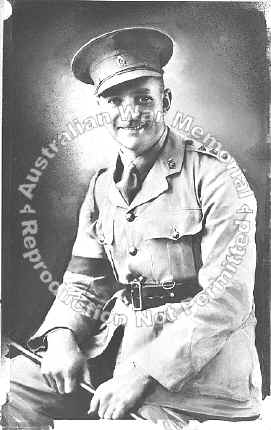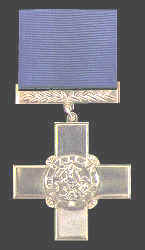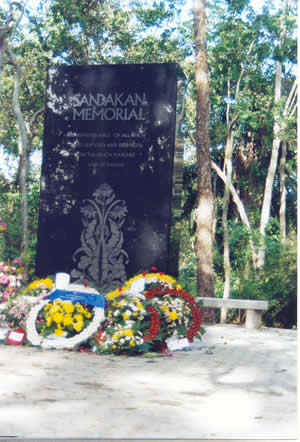 |
|
|||
|
|
||||
|
Sandakan POW Camp |
 |
VX24597 Captain L. C. Matthews GC MC, 8th Australian Division Signals.
|
||
| During this period he directed an underground intelligence
organisation and arranged delivery of sorely needed medical supplies,
food and money to the POWs. He was instrumental in arranging
a radio link with the outside world and was also responsible for
organising the British North Borneo Constabulary and the loyal natives
in Sandakan into readiness for an armed uprising against the Japanese.
He also successfully organised escape parties. Arrested by the Kempei Tai (the Japanese Gestapo) he was subjected to brutal treatment and starvation but steadfastly refused to implicate his associates. He was tried by a Military Court and executed by the Japanese at Kuching, 1944-03-02, and even at the time of his execution he defied the Japanese. The Military Cross (MC) was awarded for outstanding conduct during operations in Malaya. |
|||
| After the fall of
Singapore and Borneo to the Japanese, a Prisoner of War Camp was
established just outside of Sandakan to house approximately 750 British
and more than 1650 Australian prisoners who were sent to the camp during
the period 1942-43. In 1945, when the Japanese started to realise that
the war may have been lost, and the Allies were closing in, the
emaciated prisoners were force marched, in three separate marches, to
the village of Ranau in the jungle, 250 km away, under the shadows of
Mount Kinabalu.
On 28 January, 1945, 470 prisoners set off, with only 313 arriving in Ranau. On the second march, 570 started from Sandakan, but only 118 reached Ranau. The third march which comprised the last of the prisoners from the Sandakan camp contained 537 prisoners. Prisoners who were unable to walk were shot. The march route was through virgin jungle infested with crocodiles, snakes and wild pigs, and some of the prisoners had no boots. Rations were less than minimal. The march took nearly a year to complete. Once the surviving prisoners arrived in Ranau, they were put to work carrying 20 kg sacks of flour over very hilly terrain to Paginatan, over 40 km away. By the end of July, 1945, there were no prisoners left in Ranau. Only six Australians of the 2400 prisoners survived the "death march" - they survived because they were able to escape from the camp at Ranau, or escaped during the march from Sandakan. No British prisoners survived. This part of the war is considered by many to be the worst atrocity ever suffered by Australian soldiers, and compares to the atrocities of the Burma Railway, where fewer Australian POW's lost their lives. Those that survived the ordeal of the march, did so only because they escaped into the jungle where they were cared for by local natives. An Australian Memorial honouring the survivors, POW's, local civilians who helped by clandestinely feeding the prisoners, and soldiers who perished at Sandakan and during the death marches into the jungle, has been erected at what was the Prisoner of War Camp in Taman Rimba close to the city of Sandakan. There are just a couple of rusting bits of machinery around, and the place has an eerie air about it. The Sandakan Prisoner of War Camp has now been transformed into a very beautiful park with a pavilion on site which houses the history of this very tragic period.
|
|||||
'It was a one way trip'Second death march
to Ranau copied from http://www.dva.gov.au/media/publicat/sandakan/sand05.htm The Australian and British POWs on the second march to Ranau left Sandakan camp on 29 May 1945. Of about 530 marchers, only 100 were in any condition to embark on such an ordeal. Many knew themselves they would not get far. Within a day, one of the groups--group 2--which had left with 50 POWs had already lost 12. As with the first march, a Japanese detachment had been assigned to deal with those who fell out. As a Japanese soldier with this death squad later testified:
Nelson Short was on the second march and he recalled the bravery with which many POWs faced their end:
Dick Braithwaite became quickly aware of the purpose of this forced march:
In short, this second march was simply, if this were possible, a more brutal version of the earlier march. Rations were always totally inadequate and proper medical attention non-existent. They ate whatever they could find in the jungle. Nelson Short recalled eating snails and tree ferns. To urge them on, they were beaten with rifle butts. Men died daily of their illnesses-- some with their mates close by, others after wandering away alone into the jungle. Men who could not walk any further were shot, bayoneted or, in some instances, beheaded. One or two were killed so that a guard could take from them some treasured personal possession. About 113 died within the first eight days and a group of about 35 were massacred near Tangkul. The survivors of the second march reached Ranau on 27 June, 26 days out from Sandakan. By that time there were only 183 of them left--142 Australian and 41 British POWs. This second march had indeed been a death march. |
 |
LABUAN ISLAND. 1945-09-17. The dead body of the Japanese Commandant of Kuching & Sandakan POW Camps, Colonel Suga, who had been brought to Labuan by flying boat six days earlier and kept in a small barbed wire enclosure covered by a tent fly. Lt-Colonel Suga was formerly Commandant of Prisoner of War Compounds at Kuching and Sandakan. |
| He was apprehended as a war criminal and taken to a surrender camp at Labuan Island where he committed suicide early in the morning of 16 September. He committed suicide by stabbing his throat with a table knife, so bleeding to death. The water bottle near his head was half filled with sand and, according to the story of his batman, Kwanaka Yoshiro, who assisted his master, Suga struck himself on the head with it several times. Other reports suggest his batman aided his suicide by using his sand filled water bottle to fracture his skull. | |





